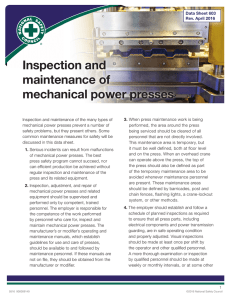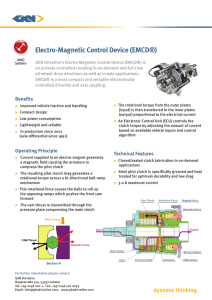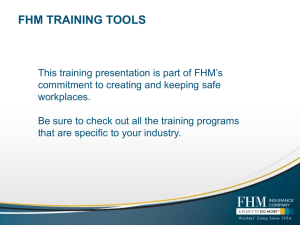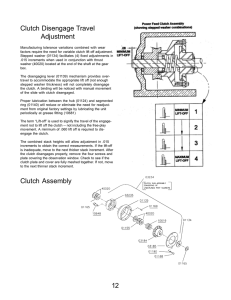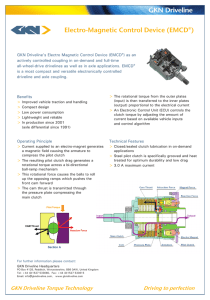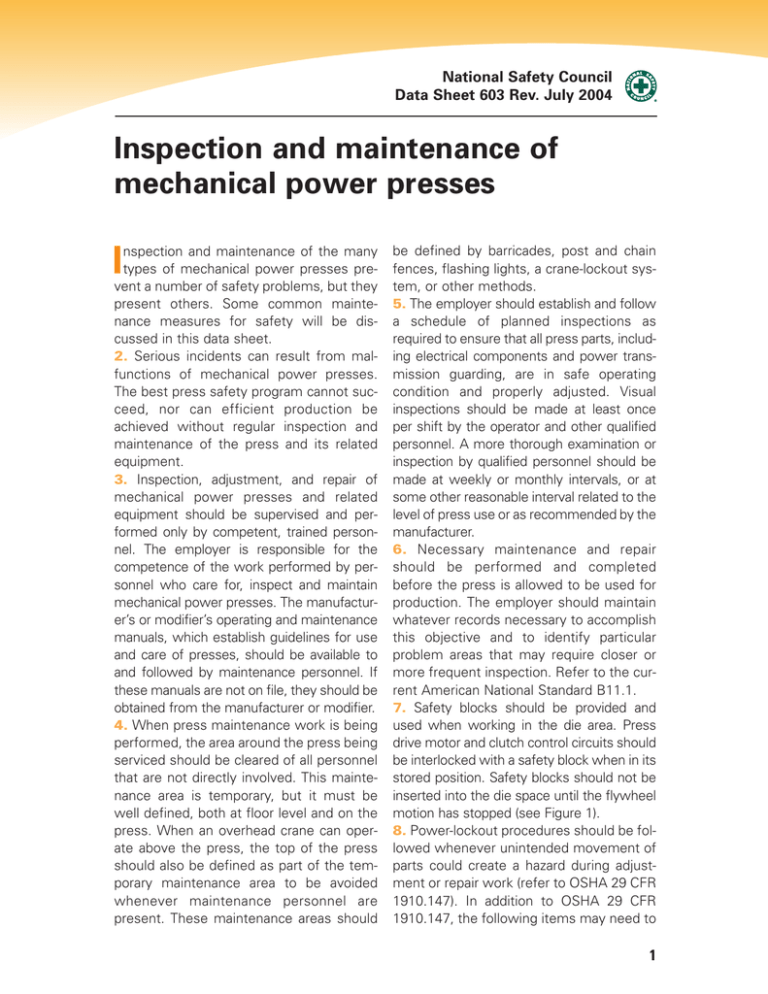
National Safety Council
Data Sheet 603 Rev. July 2004
Inspection and maintenance of
mechanical power presses
nspection and maintenance of the many
types of mechanical power presses prevent a number of safety problems, but they
present others. Some common maintenance measures for safety will be discussed in this data sheet.
2. Serious incidents can result from malfunctions of mechanical power presses.
The best press safety program cannot succeed, nor can efficient production be
achieved without regular inspection and
maintenance of the press and its related
equipment.
3. Inspection, adjustment, and repair of
mechanical power presses and related
equipment should be supervised and performed only by competent, trained personnel. The employer is responsible for the
competence of the work performed by personnel who care for, inspect and maintain
mechanical power presses. The manufacturer’s or modifier’s operating and maintenance
manuals, which establish guidelines for use
and care of presses, should be available to
and followed by maintenance personnel. If
these manuals are not on file, they should be
obtained from the manufacturer or modifier.
4. When press maintenance work is being
performed, the area around the press being
serviced should be cleared of all personnel
that are not directly involved. This maintenance area is temporary, but it must be
well defined, both at floor level and on the
press. When an overhead crane can operate above the press, the top of the press
should also be defined as part of the temporary maintenance area to be avoided
whenever maintenance personnel are
present. These maintenance areas should
I
be defined by barricades, post and chain
fences, flashing lights, a crane-lockout system, or other methods.
5. The employer should establish and follow
a schedule of planned inspections as
required to ensure that all press parts, including electrical components and power transmission guarding, are in safe operating
condition and properly adjusted. Visual
inspections should be made at least once
per shift by the operator and other qualified
personnel. A more thorough examination or
inspection by qualified personnel should be
made at weekly or monthly intervals, or at
some other reasonable interval related to the
level of press use or as recommended by the
manufacturer.
6. Necessary maintenance and repair
should be performed and completed
before the press is allowed to be used for
production. The employer should maintain
whatever records necessary to accomplish
this objective and to identify particular
problem areas that may require closer or
more frequent inspection. Refer to the current American National Standard B11.1.
7. Safety blocks should be provided and
used when working in the die area. Press
drive motor and clutch control circuits should
be interlocked with a safety block when in its
stored position. Safety blocks should not be
inserted into the die space until the flywheel
motion has stopped (see Figure 1).
8. Power-lockout procedures should be followed whenever unintended movement of
parts could create a hazard during adjustment or repair work (refer to OSHA 29 CFR
1910.147). In addition to OSHA 29 CFR
1910.147, the following items may need to
1
National Safety Council
Data Sheet 603 Rev. July 2004
reservoirs may have to be drained. In any
case, residual pressure in the lines
should be prevented. If incoming pressure lines are not equipped with lockout/blowdown valves, it is recommended
that such valves be installed.
d. Check for mechanisms that are under
spring tension or compression. Either
block, clamp or chain them in position
before disassembly.
e. Check for suspended mechanisms or
parts that normally cycle through a lower
Figure 1 shows safety switch locks. Before working
on a machine, its power must be turned off at its
control box and locked out. Each worker should have
his own padlock and key to prevent restoring power
until all work on the machine has been completed.
be considered in an employer’s evaluation
of pertinent lockout/tagout procedures.
a. Ensure that all moving parts are at rest
and, when appropriate, that the slide is
either at the bottom of the stroke or
blocked in position.
b. Check for pneumatic, hydraulic or other
pressurized devices or lines such as
used in die cushions that could be
involved in the operation. If they affect
the area under maintenance, bleed,
drain or purge them to eliminate pressure, contents, or both.
c. Valves controlling these lines (Figure 2)
should then be locked open or shut,
depending on their function and position
in the line. Air systems should be vented
to the atmosphere; surge tanks and
Figure 2 indicates how ultrasonic inspection of a press
crank can reveal fatigue cracks if any are present.
2
National Safety Council
Data Sheet 603 Rev. July 2004
position and could drop. Either lower
them to their lowest position or block,
clamp or chain them in place.
f. Check for sharp or projecting parts or
surfaces that could cut, tear or gouge.
Either remove or pad them.
g. Restore to normal conditions all equipment and/or systems that were disabled, vented or otherwise taken out of
normal operating position or condition.
Inspection
9. Mechanical power presses are subject
to heavy loads, shocks and vibrations. The
employer should refer to the manufacturer’s or the modifier’s maintenance instructions and manuals in preparing for a
complete inspection and for developing an
inspection format or procedure.
Frame
10. The press frame is the backbone of the
press. Those press members subjected to
the working (die) load are the crown,
uprights, bed and tie rods (i.e., the frame),
and the slide and connections. These load
carrying items require inspections for
cracks or fractures, particularly after a
known overload. This is particularly true if
the press has become stuck at the bottom
of the stroke position or if excessive tonnage has been exerted.
11. The press should be secured in a manner that prevents it from “walking.” When
resilient floor mountings are used, pipes
connecting to the press should be free to
move in order to prevent pipe breakage. All
fasteners must be kept tight by proper
torquing, use of lock washers, wire-locking
threaded inserts, plastic thread compound,
or as specified by the manufacturer or
modifier. When replacing special lock nuts
or high-tensile studs or screws, they
should be replaced by like, kind and quality.
Drive mechanism
12. Accuracy of slide alignment and movement must be carefully maintained to prevent die misalignment that may result in
die fracture or flying parts. Excess clearance at the gibs or in bearings located in
the connections, crankshaft, pitmans, wrist
pins, ball and socket, etc., could affect
alignment. Proper lubrication of these bearings is essential.
13. Drive belts should be properly adjusted. If they are loose, there may be excess
slippage. If they are too tight, overloading
of the motor bearings or the shaft may
occur, which may result in a premature failure. Properly adjusted belts may slip slightly on the initial start-up of a motor but
should not slip during press operation.
Tighten and secure all motor-mounting and
bracket bolts to prevent the motor from
falling. Install safety cables where there is
danger of the motor or its mounting base
falling.
14. All bearings should be properly lubricated with particular care given to shaftmounted flywheel bearings. If these
bearings should seize, they may cause
shaft rotation, shaft failure, or unintended
slide movement.
15. Whenever a crankshaft or shaft carrying the flywheel or clutch and brake is
removed from a press, it should be inspected for fatigue cracks. For presses used on
a regular basis, serious consideration
should be given to yearly inspection for
cracks, bending or deformation. Fatigue
cracks can be detected by numerous
inspection methods, including ultrasonic,
radiographic, magnetic or dye penetrant.
16. To maintain control over slide movement, keys must fit tightly and gears must
be properly timed and in good operating
condition. Loose-fitting gears may make it
difficult to keep keys tight. If keys cannot
3
National Safety Council
Data Sheet 603 Rev. July 2004
be kept tight, the cause should be determined and corrected by recutting keyways,
fitting new keys, building up the shaft or
reboring the gear as needed.
Slide or ram
17. Inspect the slide/ram-adjusting, screwlocking provisions to be sure die-shut
height can be maintained during operation.
On a press with a motorized slide/ramadjusting screw, the motor should be
checked for loose mounting bolts, loose
drive chain or gears, worn or frayed flexible
rope and loose electrical connections.
Check slide-adjustment limit switches for
proper operation and adjustment.
18. When the slide must be moved a small
amount on full-revolution clutch presses
with “bar” provisions, a spring-loaded
turnover bar, should be used after the clutch
is tripped instead of jogging the motor.
19. Make sure the bed and bolster plate is
level (see Figure 3), slide movement is perpendicular (angularity) to the plane of the
bolster plate (see Figures 4 and 5) and that
the die die-mounting surfaces are parallel
(see Figure 6).
20. If the slide is counterbalanced by
springs, the springs should be checked for
signs of fatigue or breakage. If the slide is
counterbalanced by air, a check restrictions,
correct operating pressure, loose piston
rods, lubrication, and proper operation of
the air-pressure switch. All counterbalance
systems support brackets should be tight,
with fasteners properly secured. An airpressure rise on the down stroke should be
made for air leaks. Air in the line of the
press in excess of 20 percent may indicate
a surge tank filling with condensation or
lubricant. Periodic draining of all surge tanks
is recommended to alleviate this condition.
In high humidity areas, sight gages should
be considered. Release air pressure before
performing any disassembly of air-counterbalance systems.
21. If any part of a knockout mechanism
creates a pinch point with other parts of
the press and is within reach from the floor,
the pinch point should be covered/guarded.
22. Check for fatigue cracks in the
slide/ram adjusting screw and its connection. Check for secure fastening of the
slide to the slide adjusting mechanism and
the connection to the crankshaft. All
mechanical power presses are capable of
producing an overload force several times
the press tonnage rating at the bottom of
the stroke. Sudden failure of any of the
parts attaching the slide to the crankshaft
may cause an equally sudden and dangerous dropping of the slide/ram. When
hydraulic overloads are provided, they
should be inspected for damage, broken
components, and proper adjustment in
accordance with the manufacturer’s or
modifier’s recommendations.
Cushions
23. Hazardous motion can result if air gas
or hydraulic die cushions are not de-energized properly. Care must be taken to make
sure that all pressure is removed from cushions before any maintenance has begun on
any cushion bolster or pin plate associated
with the dies. The large cylinder area common in die cushions creates great forces at
relatively low air pressure. Because of die
cushion locations, it is common that chips,
flashings and other scrap can cause them to
stick or jam in a depressed position and
appear inoperative, thus creating a serious
hazard if the situation is not properly
assessed and corrected.
24. Pressure pads and die cushions should
be examined for foreign or scrap material
between the pressure pad and the bolster.
A check should also be made for faulty
4
National Safety Council
Data Sheet 603 Rev. July 2004
Figure 3 provides a schematic of a spring-loaded turnover bar. The spring action on the end of the bar makes
it impossible to leave the bar in the bar hole. Type A shows the spring welded to the collars; Type B shows a
sliding collar with a pin riding in a slot—this design is not suitable for small bar holes. This illustration is taken
from Safety Requirements for the Construction, Care and Use of Mechanical Power Presses (ANSI B11-1).
Figure 4 shows the use of a dial indicator to check
Figure 5 shows the use of a dial indicator and
the parallelism of the slide and bolster. The indicator
square to determine that slide movement is perpen-
is moved around the periphery of the die space.
dicular to the plane of the bed.
5
National Safety Council
Data Sheet 603 Rev. July 2004
packings, leaks, improper lubrication and
loose nuts and screws on the supporting
rods or plates. Cushion pins must remain
erect to prevent binding of the pins in the
bolster holes, which can create a hazard by
the sudden release of the cushions. Out-ofround, elongated holes should be redrille to
use larger diameter pins.
Part-revolution clutch presses
25. Part-revolution clutch presses may be
arranged to function in the inch, single stoke,
or continuous modes or in a combination of
these. The various operating modes should
be checked at regular maintenance periods:
a. In the inch mode, check the inching
function of clutch and brake with the
operating control button(s). Check for
consistent clutch/brake response.
b. In single stroke mode with two-hand
control as the method for point-of-operation safeguarding, check that the motor
is running correctly in the forward direction, and additionally, verify the following
features:
• Anti-repeat
• Interrupted stroke
• Holding time capability on down stroke
• Automatic return from bottom of
stroke to top of stroke.
• Brake monitoring
• Proper run-button location from safety
distance calculations.
• Control reliability design
c. In single stroke mode operated by a single run button or a foot switch, check the
following features:
• Holding time capability on down stroke
• Automatic return from bottom to top
of stroke
• Anti-repeat
• Brake monitoring if press is so
equipped (depends on method of safeguarding used).
d. In continuous mode, check the “prior
action required” feature of the continuous control, and check the top stop feature. Check that neither single stroke nor
continuous will function unless the drive
motor is running in the forward direction.
e. Check the (emergency) stop control feature in all modes.
26. Refer to OSHA regulations, Section 29
CFR 1910.217, or appropriate state regulations for clutch-control-reliability compliance.
27. Friction-clutch units are spring released
and brake units are spring set. When the
clutch and brake are interconnected
mechanically (using a common activating
means), only one unit can be engaged at a
time when properly adjusted. When the
clutch and brake are physically separated,
each operated by its own activating means,
a sequencing means must be employed to
ensure that clutch engagement occurs after
brake disengagement and that clutch disengagement occurs before brake engagement.
Various pneumatic or electrical systems can
be used. When servicing the clutch and
brake on non-balanced machines, bring the
slide/ram to bottom of stroke position, shut
off the main drive motor, stop the flywheel,
lock out the electrical disconnect, and
exhaust the air-counterbalance system. Only
after the clutch and brake has been properly
adjusted should the proper air pressure be
restored to the counterbalance system.
28. The clutch/brake mechanism should
be checked for loose bolts and nuts, broken parts, lubrication leaks, air leaks,
excessive accumulation of particles of the
friction lining, condition of the lining and
broken springs. Always refer to the press
manufacturer’s or modifier’s specifications,
and replace parts with recommended
replacement parts. Fasteners should be
secured in accordance with manufacturer’s
or modifier’s instructions.
6
National Safety Council
Data Sheet 603 Rev. July 2004
29. The top-stop limit switches position
should not be adjusted to compensate for
brake wear.
30. Refer to the press maintenance manuals for the proper setting of the cycle-top
stop. The clutch and brake should operate
smoothly and engage and disengage quickly. The press slide should stop quickly
when the brake engages.
31. Dual, monitored, clutch/brake air valves
must be used on all machines. They should
operate smoothly, without sticking or leaking. Use of air line filters and lubricators (if
required) is essential to prevent valves from
sticking due to dirt or scale from the air line.
Leaky valve seals should be replaced.
Valves should be inspected, cleaned and
adjusted in accordance with manufacturer’s
or modifier’s recommendations. Be sure
that exhaust ports are kept clear. The
exhaust muffler should be of a type recommended by the valve manufacturer and
should be no smaller than the exhaust port
size. Mufflers should be cleaned and
inspected frequently to prevent deterioration of stopping performance. Air-line filters,
lubricators and moisture traps will increase
the life of seals and contribute to proper
operation of the clutch and brake. Traps and
strainers should be included in scheduled
maintenance and be checked and serviced
frequently. Plastic oil reservoirs and air-line
lubricators should be checked for cracks
and never cleaned with solvents that may
adversely affect plastic. Use only lubricants
recommended by the valve manufacture
that are compatible with the valve seals.
Metal bowl guards are recommended to be
used with pressurized reservoirs. Schedule
regular lubricator maintenance.
32. Proper performance of the electrical
and electronic controls affects the operation of the system. Push-buttons, limit
switches, relays and contactors should be
inspected for excessive wear broken
springs, loose parts, loose or broken wires,
peened solenoid-magnet surfaces, badly
burned contacts and dirt. Device or circuit
grounding connections should be checked
for continuity. Badly worn contacts should
be replaced in accordance with the manufacturer’s or the modifier’s recommendations. Any electrical contact or circuit should
not be jumpered to defeat its original function. Particularly, inspect the rotary limitswitch drive and its drive failure detection
system; failure of these mechanisms may
result in press stopping malfunction. Make
sure the rotary limit-switch cover is in good
repair and in place to minimize damage and
wear to the limit switch (see National
Safety Council Safety Data Sheet No. 624).
33. A wet-type (oil), air-actuated friction
clutch/brake mechanism has much the
same type of maintenance requirements
as the dry friction clutch/brake type. Refer
to manufacturer’s or modifier’s recommendations for special care.
34. The eddy current electrical clutch/brake
mechanism has no friction surfaces to maintain, but it does have slip rings and a special
electrical control to maintain the torque and
slip characteristics. Refer to the manufacturer’s recommendations for special care. If a
mechanical holding brake is incorporated
into the system, refer to paragraphs 26, 27
and 28 for proper maintenance.
Full-revolution clutch presses
35. Positive clutches are almost always
full-revolution types. Usually, a tripping
device releases a previously retracted
engaging member, permitting it to engage
with its counterpart. A full revolution of the
crankshaft must then occur before the
engaging member is retracted as it
approaches the trip mechanism. The trip
mechanism must be in its returned position
7
National Safety Council
Data Sheet 603 Rev. July 2004
prior to that time. Various designs exist,
known by different names such as pin, jaw,
dog, key, knife, rolling key, for example,
depending on the manufacturer. Usually
associated with this type of clutch is a band
or a shoe brake, which applies a continuous braking effort to the crankshaft.
36. The full-revolution clutch should be
examined for cause of abnormal noise,
loose parts, worn clutch disengagement
mechanisms, broken or weak springs, damaged lubrication seals and excessive wear
in the bearings. Proper seating or positioning of the clutch latch or cam mechanism is
extremely important. Full latch or cam contact must be made to disengage the clutch
and keep it disengaged. The engaging surfaces must not become worn or irregular.
No looseness or uncontrolled movement of
the latch mechanism can be permitted. All
fasteners and keys should be installed properly and checked for tightness, including
those that retain the flywheel or gear in its
proper position on the crankshaft. Worn or
broken parts should be replaced with manufacturer’s replacement parts. The clutch
must be maintained and adjusted to conform to the information provided by its manufacturer or modifier.
37. Unless a full-revolution press is dedicated to continuous stroking using automatic feed exclusively, it should be
equipped and operated with an anti-repeat
system or a mechanical single-stroke
mechanism. If an electro-pneumatic, antirepeat system is used, it should be
checked in a method similar to that
described in paragraph 31. Care should be
taken to provide appropriate air pressure
and length of travel to the pull-rod operating cylinder to avoid damage to the clutch
mechanism or excessive clutch wear.
38. On some full-revolution presses, the
press cycle may over travel its top-stop
position because the brake is incapable of
stopping the slide quickly. If severe
enough, this over-travel can damage the
mechanism and may cause clutch reengagement. It is characteristic of many
mechanically actuated clutch and brake
mechanisms that the press may appear to
be functioning properly while actually malfunctioning. All braking mechanisms must
effectively stop and hold the crank in its
top-stop position. Care must be taken
through preventive maintenance to evaluate and correct poor braking before failures
and malfunctions occur.
39. Operators must be trained to notice
any change in the performance or sound of
the press. Any change should be reported
to supervision immediately. Do not continue operation until the press has been carefully inspected and necessary repairs are
completed.
Modifications
40. Modifications to a press should not
be undertaken without understanding the
impact such modifications may have on
press performance and safety. There are
construction features that may relate to
safety that are not readily seen. Modifications should be discussed with the original manufacturer or the modifier before
proceeding.
Sources of information
American National Standards Institute, 1430
Broadway, New York, NY 10018. Safety Requirements
for the Construction, Care and Use of Mechanical
Power Presses, ANSI B11.1. Lockout/Tagout, ANSI
Z244.1.
National Safety Council, 1121 Spring Lake Drive,
Itasca, IL 60143-3201. Electrical Controls for
Mechanical Power Presses, Data Sheet 624.
Code of Federal Regulations: Title 29—Labor; Part
1910—“Occupational Safety and Health Standards.”
Available through U.S. Government Printing Office,
Washington, DC 20402.
8
National Safety Council
Data Sheet 603 Rev. July 2004
Acknowledgment
This data sheet was revised by the
Automotive, Metals and Power Press
(AMPS) Section of the Business & Industry
Division, National Safety Council, 1121
Spring Lake Drive, Itasca, IL 60143-3201.
Copyright ©2008 National Safety Council.
All rights reserved.
Although the information and recommendations contained in this publication have been compiled from
sources believed to be reliable, the National Safety
Council makes no guarantee as to, and assumes no
responsibility for, the correctness, sufficiency or
completeness of such information or recommendations. Other or additional safety measures may be
required under particular circumstances.
9

